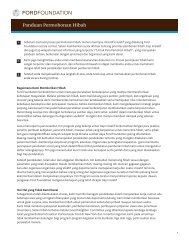Inclusive Scholarship: Developing Black Studies - Ford Foundation
Inclusive Scholarship: Developing Black Studies - Ford Foundation
Inclusive Scholarship: Developing Black Studies - Ford Foundation
Create successful ePaper yourself
Turn your PDF publications into a flip-book with our unique Google optimized e-Paper software.
<strong>Inclusive</strong> <strong>Scholarship</strong>: <strong>Developing</strong> <strong>Black</strong> <strong>Studies</strong> in the United States 93<br />
The second stage for Africana <strong>Studies</strong> began with the study of <strong>Black</strong><br />
America by Gunnar Myrdal. This stage was in some respects a setback.<br />
Myrdal, who began his project for the Carnegie Corporation in 1939, confined<br />
his analysis to theAmerican social,political,and economic order.There<br />
was growing concern about the role and place of the <strong>Black</strong> population during<br />
the Second WorldWar,as a majority of AfricanAmericans became urban.<br />
<strong>Black</strong> migration northward, which had begun in large numbers during the<br />
1890s, had accelerated during World War I, and had slowed during the Depression<br />
of the 1930s, mushroomed during World War II, making the <strong>Black</strong><br />
presence in America more a national than a regional or primarily southern<br />
concern.Believing that <strong>Black</strong> people in the United States were fundamentally<br />
Americans who had no significant African cultural background or identity,<br />
Myrdal accepted the formulation of the University of Chicago School of Sociology<br />
that ethnic and racial contact led not only to conflict but also to inevitable<br />
assimilation and absorption into the dominant society. His<br />
two-volume study, An American Dilemma: The Negro Problem and Modern<br />
Democracy, published in 1944, had an important influence on scholarship,<br />
especially the work of white academics during this second stage.<br />
White scholars, by and large, had ignored <strong>Black</strong> people. The Columbia<br />
University historian John W. Burgess had boldly stated: “[A] <strong>Black</strong> skin<br />
means membership in a race of men which has never itself succeeded in<br />
subjecting passion to reason; has never, therefore, created any civilization<br />
of any kind.” After World War II, as the <strong>Black</strong> population in the United<br />
States became predominantly urban and as scholarship in general shed notions<br />
of inherent racial inferiority and superiority with the Nazi debacle,<br />
white scholars devoted increasing attention to African Americans’ status in<br />
the United States. They sought environmental rather than biogenetic explanations<br />
for African Americans’ inferior status.<br />
In Mark of Oppression (1951), Abram Kardiner and Lionel Ovesey hypothesized<br />
that African Americans emerged from slavery without a culture,<br />
with “no intra-psychic defenses—no pride, no group solidarity, no tradition.”<br />
They argued:“The marks of his previous status were still upon him—<br />
socially, psychologically, and emotionally—and from these he has never<br />
since freed himself.” Stanley Elkins in his book Slavery (1959) concluded

















